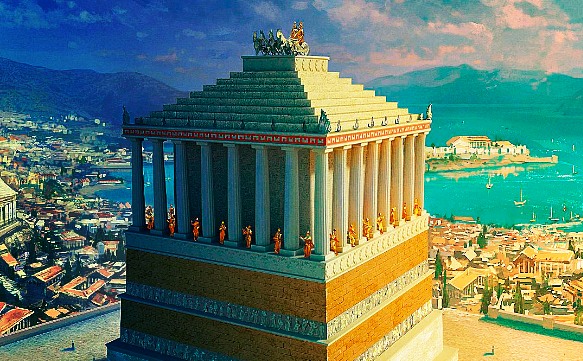


Travel Tips 18.04.2023 2116
Halicarnassus Mausoleum is one of the ancient wonders of the world, located in present-day Bodrum, Turkey. The mausoleum was built in the 4th century BC as a tomb for King Mausolus of Caria and his wife Artemisia II. It was considered one of the greatest achievements of ancient Greek architecture, but unfortunately, the mausoleum was destroyed by earthquakes in the Middle Ages. However, its ruins and the history behind it still make it an interesting attraction for tourists visiting Turkey. In this article, we will delve into the history of Halicarnassus Mausoleum, its location, and everything you need to know about it.
Halicarnassus Mausoleum is located in the city of Bodrum, which is situated in the southwestern coast of Turkey. Bodrum is known for its beautiful beaches, scenic views, and its rich history. The mausoleum is situated in the city center, near the harbor, and is easily accessible by car or public transportation.
Halicarnassus Mausoleum was built between 353-350 BC by Greek architects Satyros and Pytheos. The mausoleum was constructed as a tomb for King Mausolus of Caria, who died in 353 BC, and his wife Artemisia II, who ruled Caria after Mausolus' death. The mausoleum was built on a hill overlooking the city and the harbor and was surrounded by gardens and sculptures.
The mausoleum was constructed with marble and was decorated with intricate sculptures and reliefs. The structure was 45 meters tall and had four sides, each adorned with sculptural friezes depicting scenes from Greek mythology and battles. The roof of the mausoleum was adorned with a statue of King Mausolus riding a chariot, pulled by four horses.
Halicarnassus Mausoleum was considered one of the greatest examples of ancient Greek architecture and was a popular tourist attraction in ancient times. The mausoleum was also a symbol of the power and wealth of the Hellenistic world.
Halicarnassus Mausoleum, 7 Wonders of the World
Halicarnassus Mausoleum was one of the seven wonders of the ancient world, along with the Great Pyramid of Giza, the Hanging Gardens of Babylon, the Temple of Artemis at Ephesus, the Colossus of Rhodes, the Lighthouse of Alexandria, and the Statue of Zeus at Olympia.
The seven wonders of the ancient world were considered to be the greatest achievements of human civilization and were a source of wonder and inspiration for people of all ages. Unfortunately, only one of the seven wonders, the Great Pyramid of Giza, still exists today. The rest of them were destroyed by natural disasters, wars, or simply disappeared over time.
The Halicarnassus Mausoleum was destroyed by earthquakes in the Middle Ages, and its ruins were used to construct other buildings. However, its legacy still lives on, and the ruins of the mausoleum are still an important attraction for tourists visiting Bodrum.
Tomb of King Mausolus (Mausoleum of Halicarnassus)
The Halicarnassus Mausoleum is also known as the Tomb of King Mausolus. King Mausolus was a ruler of Caria, a region in present-day Turkey, and was known for his wealth and power. He ruled Caria from 377-353 BC and was responsible for many important architectural projects in the region Aside from the Halicarnassus Mausoleum, King Mausolus is also known for commissioning the construction of the city of Halicarnassus, which later became his capital. He was a patron of the arts and was known to have invited many Greek artists and architects to work on his projects.
The construction of the Halicarnassus Mausoleum was a way for King Mausolus to immortalize himself and his wife Artemisia II. The mausoleum was not only a tomb but also a symbol of their wealth, power, and influence. It was meant to impress and awe visitors and to serve as a testament to their legacy.
Unfortunately, the mausoleum was destroyed over time, and its remains were used to build other structures. However, in the 19th century, British archaeologist Charles Thomas Newton discovered the ruins of the mausoleum and started excavating the site. Today, visitors can see the remains of the mausoleum, including the sculptures and reliefs that once adorned its walls.
Visiting the Halicarnassus Mausoleum
The Halicarnassus Mausoleum is a popular attraction for tourists visiting Bodrum. Visitors can see the remains of the mausoleum, including the sculptures and reliefs that once adorned its walls. The site is also surrounded by gardens and offers stunning views of the city and the harbor.
Aside from the mausoleum, there are other attractions in Bodrum that visitors can enjoy. The city is known for its beautiful beaches, clear waters, and lively nightlife. There are also several museums and historical sites, such as the Bodrum Castle and the Museum of Underwater Archaeology, which offer a glimpse into the region's rich history.
When visiting the Halicarnassus Mausoleum, it's important to be respectful of the site and its history. Visitors should follow the rules and regulations set by the authorities and avoid causing any damage to the site.
The Halicarnassus Mausoleum is a testament to the power and influence of the ancient Greek world. Built as a tomb for King Mausolus and his wife Artemisia II, the mausoleum was considered one of the greatest achievements of ancient Greek architecture. Although it was destroyed over time, its remains still offer a glimpse into its past glory.
Visitors to Bodrum can explore the remains of the mausoleum and learn about its history and significance. The city also offers other attractions, such as its beautiful beaches, museums, and historical sites. Whether you're interested in ancient history, art, or just want to relax and enjoy the sun, Bodrum and the Halicarnassus Mausoleum are definitely worth a visit.
Blog Categories